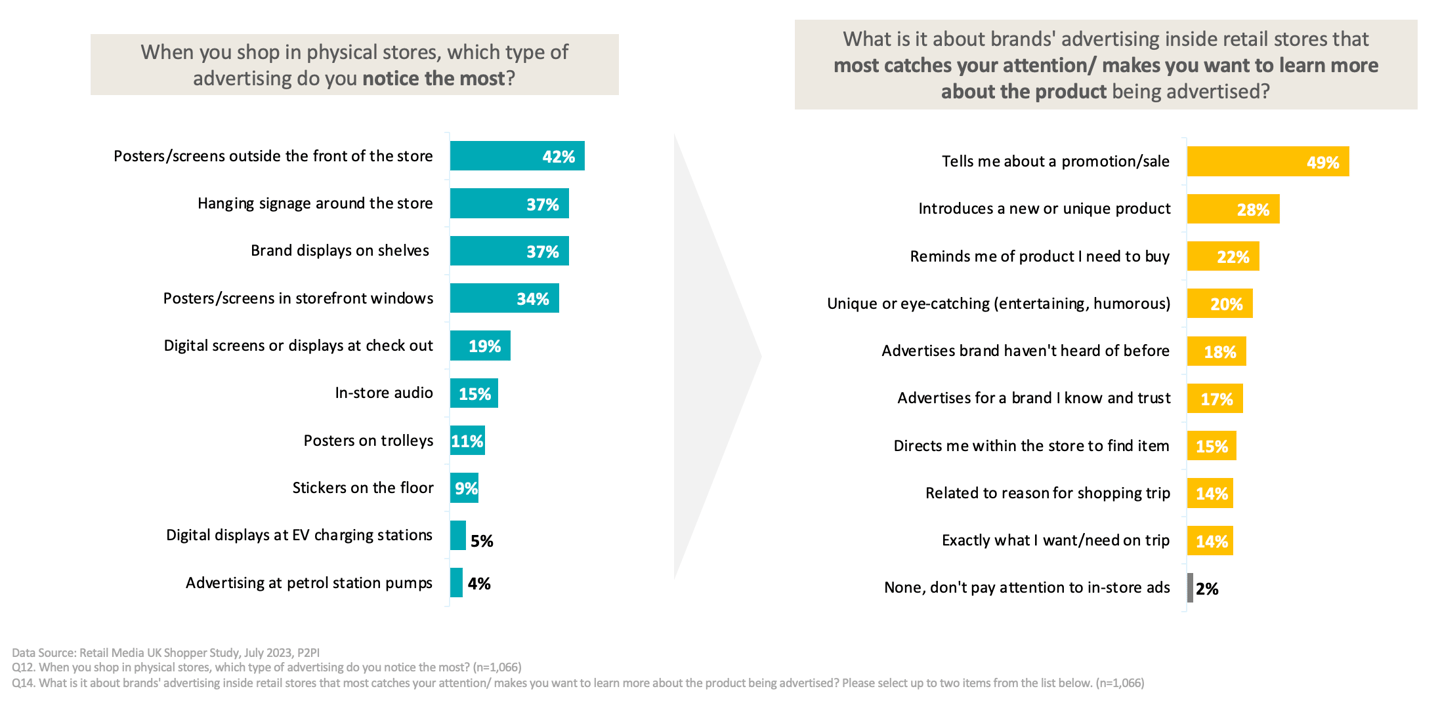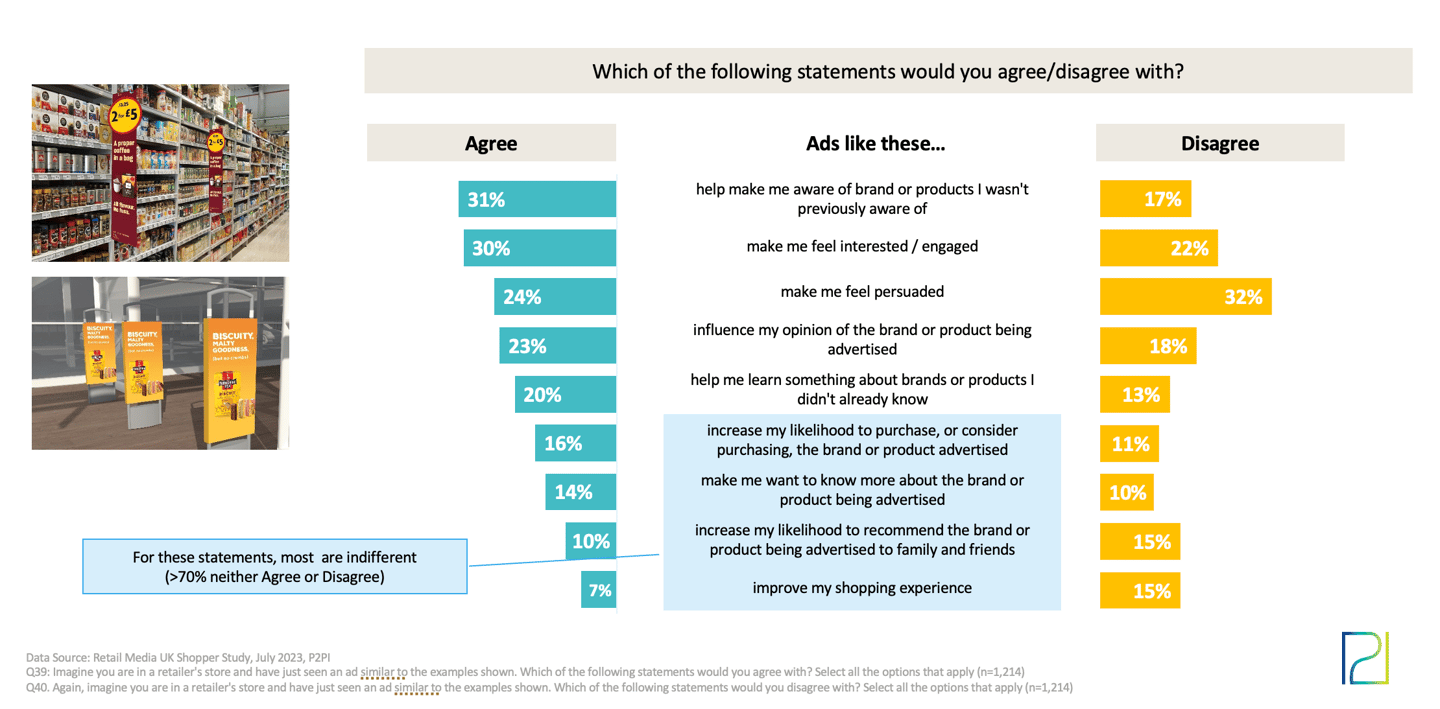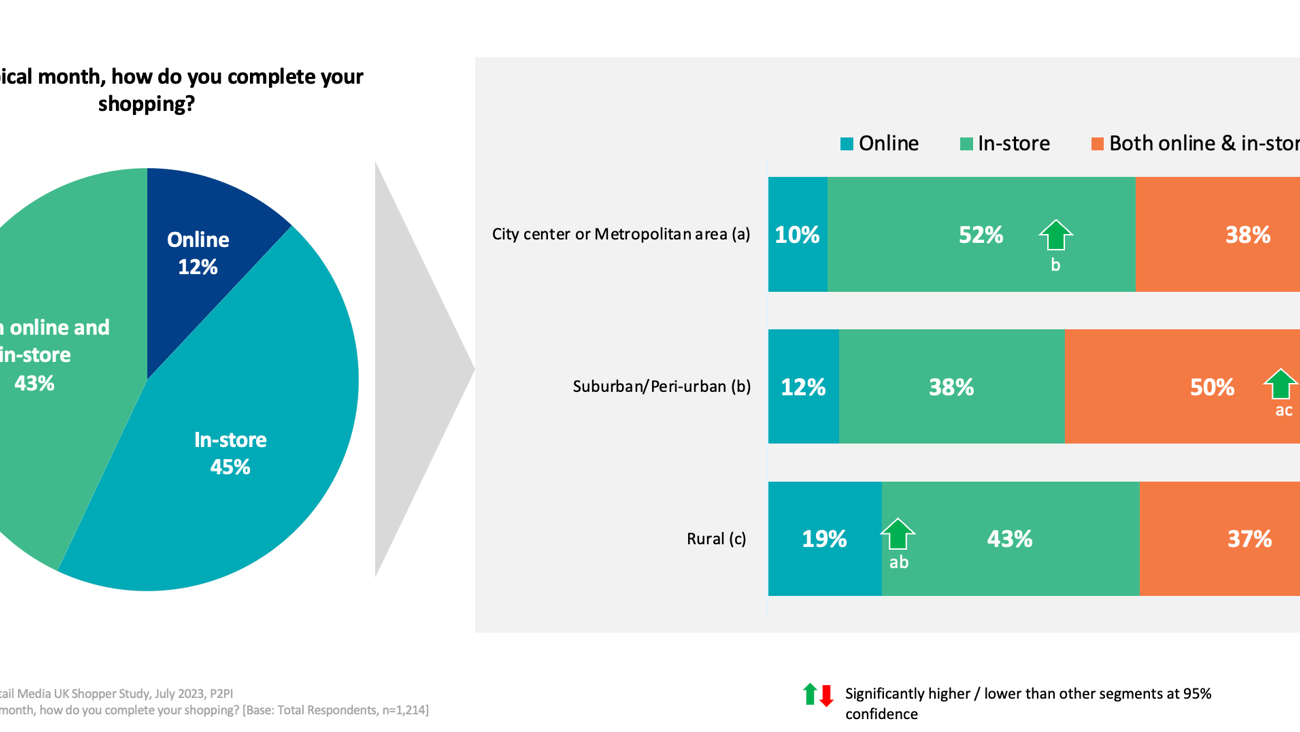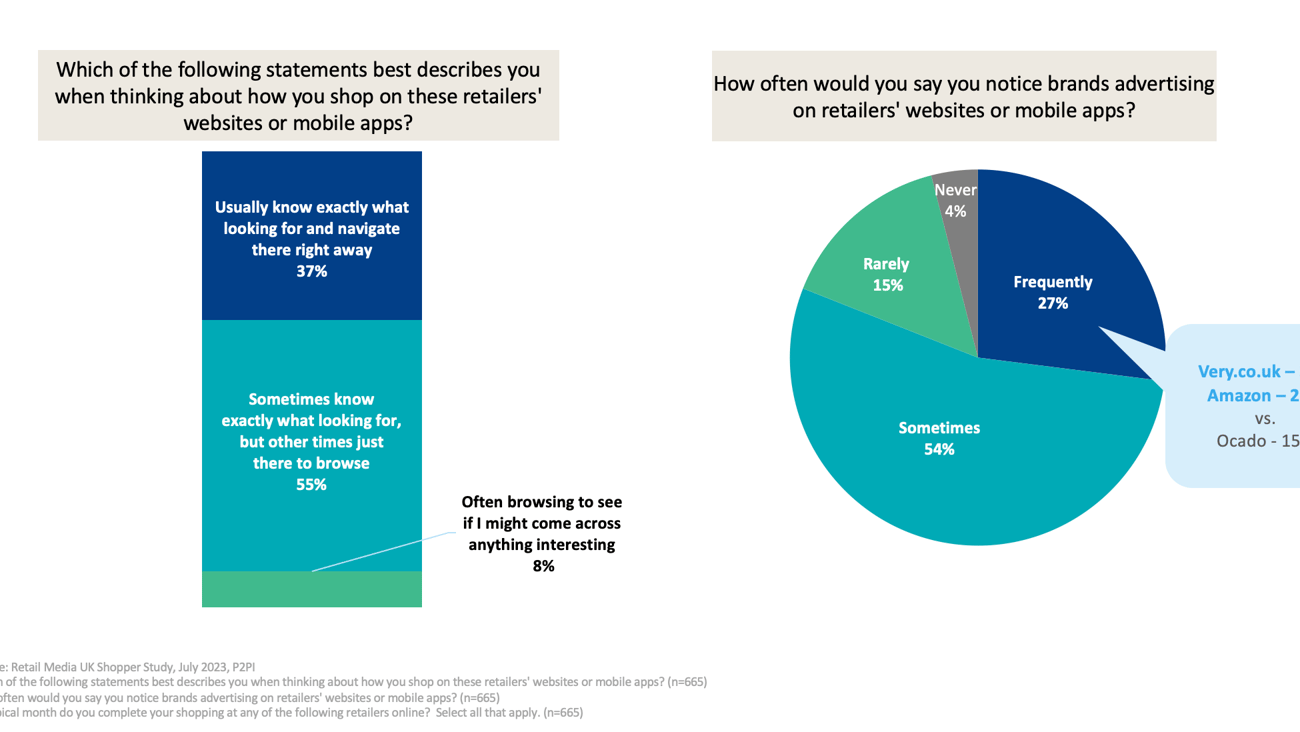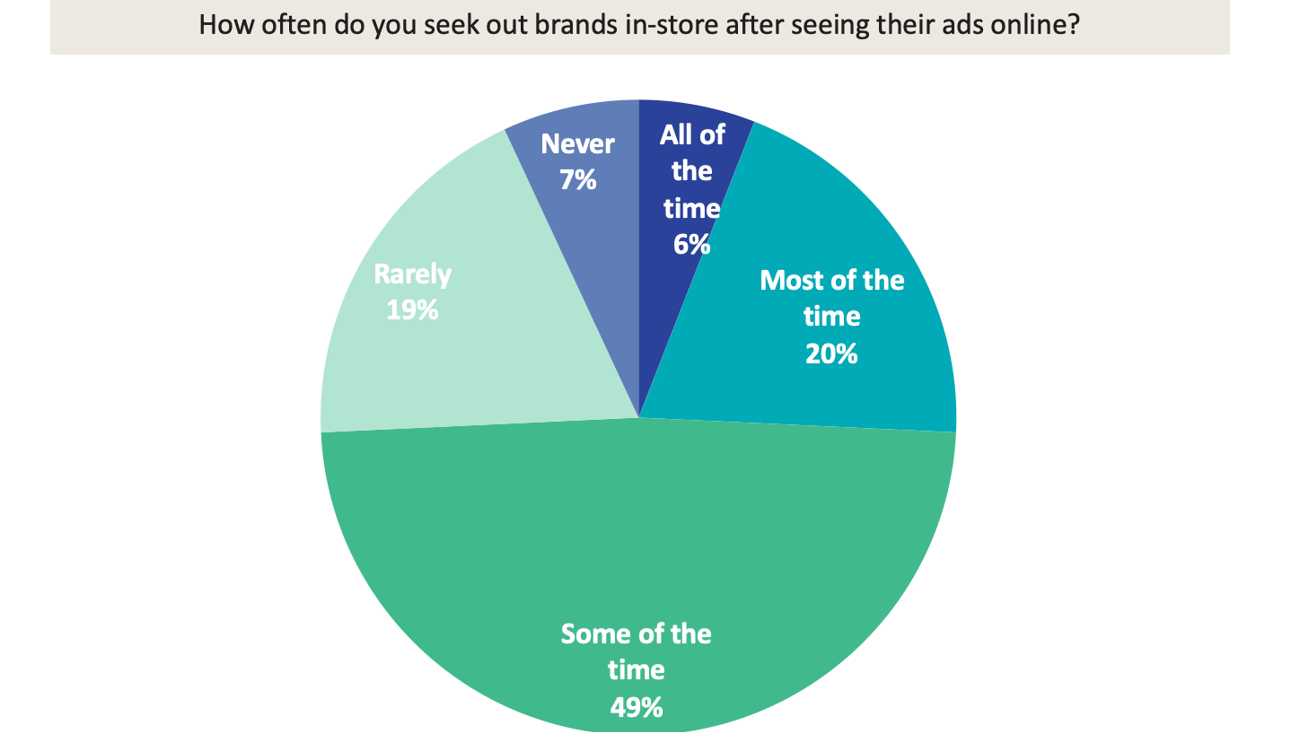Shopper Perceptions of Retail Media Across the Pond
Retail media's impact and influence in the commerce marketing world is hard to ignore — and the space is just going to continue to grow. IAB Europe forecasts that online retail media ad spend will exceed traditional linear TV ad spend by 2026 to reach 25 billion euros. (Retail media is closing in on traditional TV in the U.S., too.)
While commerce marketers are familiar with retail media — and its growing importance in the industry — the average consumer has little or no knowledge of what retail media is or what an activation looks like out in the wild. Knowing the importance of shoppers' perceptions of retail media, the Path to Purchase Institute, in collaboration with SMG, fielded a study of more than 1,200 U.K. shoppers from July 25 through Aug. 2 to understand how retail media touches and is received by shoppers along the path to purchase.
Participant demographics
The 1,214 survey respondents were almost evenly split between male and female (50% male, 49% female and 1% non-binary); most resided in the city center/metropolitan (49%) area, followed by suburban/peri-urban (39%) and rural (12%) areas; and a majority were Millennials (58%), with some Gen Zers (19%), Gen Xers (18%) and Baby Boomers (3%). A majority (61%) of respondents had a college degree, a postgraduate degree or at least attended university or college, while 19% indicated having at least some secondary school or high school education, if not a diploma, and 11% had at least some technical education. Considering their employment status, 37% identified as employed full time, 12% worked part time, 21% were unemployed and the rest of the participants ranged from students to retired individuals. Looking more closely at the participants’ financial situations:
- 20% indicated they could afford food and regular expenses, but nothing else;
- 19% said they could comfortably afford food, clothes and furniture, and have savings;
- 17% felt they could afford food, but nothing else;
- 13% could afford food, regular expenses and clothes, but nothing else;
- 13% could comfortably afford food, clothes and furniture, but didn’t have savings;
- 6% said they could not afford enough food for their family; and
- 13% preferred not to answer the question.
Shopping habits and preferences
For the most part, the respondents we spoke to enjoy either in-store or omnichannel shopping. When asked how they completed their shopping in a typical month, 43% of respondents said in-store and online, while 45% indicated in-store only and 12% said solely online. Considering responses based on an individual's geography:
- 52% of those from city centers and metro areas indicated shopping in-store only, followed by both in-store and online (38%), and online-only (10%);
- 50% of suburban and peri-urban shoppers indicated both in-store and online, followed by in-store only (38%) and online only (12%); and
- 43% of rural consumers indicated in-store only, followed somewhat closely by a mix of in-store and online (37%) and online only (19%).
No surprises here, but a majority of respondents (60%) shop at Tesco, as well as Boots (55%), Aldi (56%) and Lidl (55%) either in-store or online in a typical month. Half of respondents also indicated shopping at Asda and Amazon. A few observations based on the participants and where they shop:
- Waitrose shoppers are more highly educated than shoppers of other grocery retailers, but have a higher proportion of unemployed.
- Compared to Superdrug shoppers, more Boots shoppers work full time and fewer are unemployed.
- More than half (56%) of Poundland shoppers live in a city center/metro area, and 1 in 4 (28%) are unemployed.
Shopper advertising preferences: In-Store
The next insight should come as welcome news for marketers hoping to connect with shoppers in brick-and-mortar stores: Most in-store shoppers (83%) indicated enjoying seeing or hearing about products available at the retailers and were open to considering purchasing them during their current shopping trip or a future one. Fifteen percent said they didn't pay much attention or notice advertising when shopping in-store, and only 2% found in-store advertising intrusive or taking away from their shopping experience.
When asked what type of advertising they notice most in stores, 42% pointed to posters/screens outside the front of stores, 37% selected hanging signage around the store, 37% said brand displays on shelves and 34% said posters/screens in storefront windows. Taking it a step further, we asked respondents what it is about a brand’s advertising inside retail stores that most catches their attention or makes them want to learn more about the product being advertised. For this question, nearly half of survey takers (49%) indicated being most attracted to advertising that communicates a promotion or sale, followed by ads that:
- Introduce them to a new product (28%);
- Remind them of a product they needed to buy (22%); and
- Are unique or eye-catching (entertaining, humorous) (20%).
Shopper advertising preferences: Online
Changing the focus to retailers’ online activity, we asked respondents why they typically visit retailers’ websites or mobile apps. Looking for promotions, deals and coupons (60%) garnered the most responses, followed by comparing prices with other retailers (44%), browsing products and finding inspiration (40%), repurchasing items they buy regularly (36%) and finding a nearby location (34%).
When asked to consider their shopping habits on a retailer's website or mobile app, 37% of respondents shared that they know exactly what they are looking for and navigate there right away, while a majority (55%) indicated they sometimes know exactly what they are looking for, but other times are just on a retailer’s online platform to browse. Only 8% of survey takers indicated often browsing to see if they might come across anything interesting on a retailer's site. When asked how often they would notice brand’s advertising on retailers’ websites or apps, 54% said sometimes, 27% indicated frequently and only 19% selected rarely or never.
While a majority of online shoppers told us they at least sometimes know exactly what they're looking for on a retailer’s site, 43% of survey takers indicated liking when retailers suggest new products to them while shopping on their websites. Moreover, 38% of participants said they enjoyed when retailers show they know them by advertising products they have purchased or are considering purchasing. However, there still seems to be room for improvement when it comes to engaging shoppers through on-site advertising: nearly a quarter of respondents (24%) said they rarely click on or engage with online ads and only one-fifth said they have made purchases based on seeing an ad on a retailer’s site or app.
Retail media across the path to purchase
Next, we showed survey takers a variety of advertising tactics. Noting to consider only the type of ad in the examples shared (and not the products advertised or images and messages used in the ad), we asked respondents how often they noticed these types of ads. Results showed that when it came to:
- Sponsored social media posts and ads in retailer-owned magazines, 80% of respondents said they at least sometimes notice ads like these and 21% said never or rarely do;
- Out-of-home ads at bus stops and ads on double-decker buses, 82% said they at least sometimes notice ads like these with 18% noting they never or rarely do;
- Off-platform display ads, 75% said they at least sometimes notice ads like these and 25% said never or rarely;
- On-platform display ads and mobile app notifications, 73% said they at least sometimes notice ads like these and 28% noted they never or rarely; and
- In-store ads, 85% notice these ads at least sometimes and 16% rarely or never do.
Next, we asked survey takers to choose if they disagreed or agreed with specific statements on each ad type, ranging from "ads like these make me feel persuaded" to "ads like these help make me aware of brands or products I wasn't previously aware of." Respondents generally agreed that the ads shown helped with brand and product awareness, but said they did not feel persuaded by them. Besides in-store signage, participants also generally indicated that the ad examples shown did not make them feel interested or engaged. In-store ads were the only marketing tactic where 30% of respondents agreed the ads made them feel interested or engaged.
In order to dig a bit deeper, we asked shoppers what it was about a brand's ad in the examples shown that captured their attention or made them want to learn more about the product being advertised. "Offers a discount or promotion" was selected by a majority (60%) of respondents, followed by "introduces me to a new or unique product" (31%), "reminds me of a product I have recently viewed" (24%), "is a brand I know and trust" (15%) and "is personalized to my browsing/shopping history" (14%).
We also asked participants, when thinking about advertisements that they've seen whilst at home, out and about, online or in store, how often they tell people about those products they've seen advertised. More than 6 in 10 tell others about products they have seen advertised at least sometimes. When considering who does so frequently, those in rural areas are more likely to do so versus other geographic types.
Finally, we asked how often survey takers shop for or purchase products based on the content from retailers on social media and almost two-thirds (63%) indicated at least sometimes.
While the results of the report garnered much data to comb through, a couple things were clear and validated some internal hypotheses. First, the power of in-store advertising shone bright with a vast majority (83%) of in-store shoppers indicating they enjoy seeing or hearing about products available at a retailer, and in-store signs and displays being the leading tactic from the examples we shared that respondents noticed at least sometimes. Moreover, in-store ads were the only marketing tactic where nearly a third (30%) of respondents agreed the ads made them feel interested or engaged.
Retail media plays a significant role in the upper funnel, too, with respondents generally agreeing that all the ads we shared (in-store ads, OOH ads, off-platform and on-platform display ads, sponsored social media posts, ads within retailer-owned magazines and on double-decker buses) helped with brand and product awareness. Considering all this, it reinforces the importance of activating a holistic campaign across the path to purchase and understanding retail media's value beyond short-term sales.
For more insights and analysis from the research, view "The Power of Retail Media Beyond Short Term Sales & ROI" session recording from October's Retail Media Summit UK in London.


